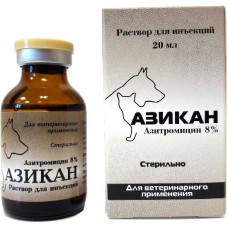Expiration date: 01/2026
DESCRIPTION
Azikan is a new highly effective broad-spectrum antibacterial drug. Product form: solution for injection. In appearance, Azikan is a clear solution of colorless to slightly yellow color.
ADVANTAGES
- Right on target-azithromycin is transported by immune cells to the site of infection.
- Will find and destroy-effective for both extracellular and intracellular infections.
- Convenient use — the course of treatment is 2-3 intramuscular injections with an interval of 48 hours.
- Broad spectrum of antimicrobial activity-active against gram-positive and gram-negative microorganisms, anaerobes, chlamydia and mycoplasmas.
- Therapeutic latitude-used for diseases of the respiratory system, genitourinary system, infectious diseases of the skin and soft tissues.
- Reliable result-effective in severe, chronic and advanced cases of the disease.
STRUCTURE
Azikan as an active substance in 1 cm3 of the solution contains 80 mg of Azithromycin in the form of dihydrate, and as auxiliary components 20 mg of lidocaine hydrochloride, citric acid and sodium hydroxide in the amounts necessary to correct pH=6.0 and water for injection up to 1 cm3.
PHARMACOLOGICAL PROPERTIES
Azikan is an antibacterial drug from the azalide group.
Azithromycin, which is part of Azikan, is a broad-spectrum antibacterial agent. It acts bacteriostatically.
Binding to the 50S subunit of ribosomes, it inhibits peptidtranslase at the translation stage, suppresses protein synthesis, slows down the growth and reproduction of bacteria, and has a bactericidal effect in high concentrations. It acts on extracellular and intracellular pathogens.
Azithromycin is active against:
Gram-positive microorganisms: Streptococcus spp. Streptococcus pneumoniae, Streptococcus pyogenes, Streptococcus agalactiae, Streptococcus viridans, Staphylococcus epidermidis, Staphylococcus aureus; gram-negative bacteria: Haemophilus influenzae, Moraxella catarrhalis, Bordetella pertussis, Bordetella parapertussis, Legionella pneumophila, Haemophilus ducreyi, Campylobacter jejuni, Neisseria gonorrhoeae and Gardnerella vaginalis;
anaerobic microorganisms: Bacteroides bivius, Clostridium perfringens, Peptostreptococcus spp;
Chlamydia and Mycoplasma: Chlamydia trachomatis, Chlamydia pneumoniae, Mycoplasma pneumoniae, Mycobacterium avium complex, Ureaplasma urealyticum, Treponema pallidum, Borrelia burgdorferi.
Pharmacokinetics: After intramuscular administration of Azikan, the bioavailability of azithromycin is 90%. The maximum concentration of azithromycin in the blood reaches a maximum after 2 hours. The half-life is 13-14 hours. The therapeutic concentration in the blood is maintained for at least 48 hours. Azithromycin is transported by phagocytes, polymorphonuclear leukocytes, and macrophages to the site of infection, where it is released in the presence of bacteria.
According to the degree of exposure to the body, Azikan belongs to low-risk substances (hazard class 4 according to GOST 12.1.007-76).
DOSAGE AND APPLICATION
Azikan is prescribed to dogs and cats for the treatment of diseases caused by microorganisms sensitive to azithromycin (infections of the respiratory and genitourinary systems, infectious diseases of the skin and soft tissues, etc.).
Azikan is used for dogs and cats intramuscularly.
A single dose is 1.0 cm3 per 10 kg of animal weight, which is equivalent to 8 mg of azithromycin per 1 kg of animal body weight.
The interval between injections is 48 hours.
In most cases, the course of treatment is two injections. In cases of severe disease, a third injection may be required.
SPECIAL INSTRUCTIONS
Conditions of release: without a prescription from a veterinarian.
Features of use in pregnant animals have not been established. The use of Azikan during lactation is not recommended, since the drug is excreted in milk.
Skipping the next dose of the drug should be avoided, as this can lead to a decrease in therapeutic effectiveness. If you miss one or more doses of the drug, treatment should be resumed as soon as possible in the prescribed dosage and regimen.
The use of Azikan does not exclude the use of symptomatic and pathogenetic therapy.
Drug interaction: Combined use with chloramphinecol and tetracycline antibiotics enhances the antibacterial effect of azithromycin.
Combined use with lincomycin leads to a decrease in effectiveness.
It is possible to increase the toxicity of digoxin.
CONTRAINDICATIONS
The use of Azikan in animals with hypersensitivity to macrolide antibiotics is contraindicated. It is not recommended to use in animals with renal insufficiency, due to the available data on an increase in creatinine in response to high doses of the drug.
SIDE EFFECTS
When using Azikan in accordance with the instructions, side effects and complications are usually not observed.
Possible soreness and swelling at the site of administration of Azikan. There may be depression, lethargy, refusal of food and lameness. These phenomena pass independently within a few hours.
In case of allergic reactions, the use of the drug is discontinued and, if necessary, antihistamines or other symptomatic treatment are prescribed.
SHELF LIFE AND STORAGE
The shelf life of Azikan, subject to storage conditions, is 2 years from the date of production. After the first opening of the bottle, Azikan should be used within 28 days. Azikan should not be used after the expiration date.
Azikan is stored in the closed packaging of the manufacturer, separately from food and feed, in a dry place protected from direct sunlight at a temperature of 5°C to 25°C.


